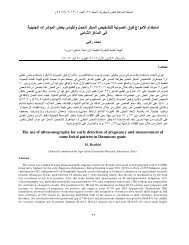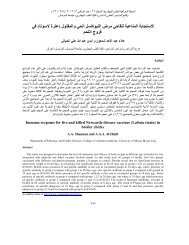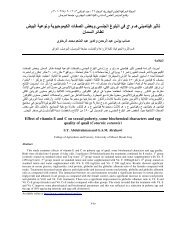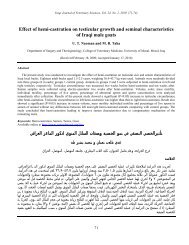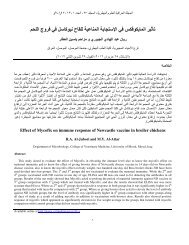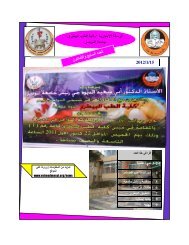fulltext (pdf) - College of Veterinary Medicine, University of Mosul, Iraq
fulltext (pdf) - College of Veterinary Medicine, University of Mosul, Iraq
fulltext (pdf) - College of Veterinary Medicine, University of Mosul, Iraq
You also want an ePaper? Increase the reach of your titles
YUMPU automatically turns print PDFs into web optimized ePapers that Google loves.
<strong>Iraq</strong>i Journal <strong>of</strong> <strong>Veterinary</strong> Sciences, Vol. 26, Supplement III, 2012 (95-103)<br />
Proceedings <strong>of</strong> the 6 th Scientific Conference, <strong>College</strong> <strong>of</strong> <strong>Veterinary</strong> <strong>Medicine</strong>, <strong>University</strong> <strong>of</strong> <strong>Mosul</strong><br />
Table (2) shows four species <strong>of</strong> ticks which were<br />
identified from the genera Hyalomma (H. a anatolicum, H.<br />
marginatum), the highest number and percentage species<br />
were H. a anatolicum 608 (51.9%), H. marginatum 122<br />
(10.4%), and genera Rhipicephalus, R. sanguineus 90<br />
(7.7%) and R. turanicus 351 (30%) during the study year.<br />
Table (2): Number and percentage <strong>of</strong> different tick species identified in 3 zones in Suliamani governorate.<br />
Zones<br />
Zone- 1<br />
Zone- II<br />
Zone-III<br />
Total<br />
No. & (%)<br />
R. sanguineus<br />
23<br />
7.7<br />
20<br />
5.4<br />
47<br />
9.3<br />
90<br />
7.7<br />
Genus: Rhipicephalus<br />
No. &(%)<br />
R. turanicus'<br />
177<br />
59.4<br />
124<br />
33.6<br />
50<br />
10.0<br />
351<br />
30.0<br />
No. & (%)<br />
H. a anatolicum<br />
64<br />
21.5<br />
191<br />
51.8<br />
353<br />
70.0<br />
608<br />
51.9<br />
Genus: Hyalomma<br />
No. & (%)<br />
H. marginatum<br />
34<br />
11.4<br />
34<br />
9.2<br />
54<br />
10.7<br />
122<br />
10.4<br />
Total<br />
No.<br />
Ticks<br />
298<br />
369<br />
504<br />
1171<br />
The data in table (3) show that the distribution <strong>of</strong> tick<br />
species during different months <strong>of</strong> the study according to<br />
Chi square test showed fluctuation in the occurrences. The<br />
number <strong>of</strong> H anatolicum anatolicum was highly distributed<br />
in March, April, May, and June 61 (75.3%), 89 (69%), 92<br />
(68.7%), and 50 (74.6%), respectively in zone-III and<br />
Rhipicephalus sanguineus was highly distributed in April,<br />
May, and June 11 (8.5%), 13 (9.7%), and 10 (14.9%)<br />
respectively in zone-III in comparison with other zones,<br />
while the number <strong>of</strong> Hyalomma marginatum was highly<br />
distributed in April and May 18 (14%) and 16 (11.9%) in<br />
zone-III comparing to other zones and the number <strong>of</strong><br />
Rhipicephalus turanicus was highly distributed in zone-I in<br />
March, April and May 23 (71.8%), 48 (71.6%), and 57<br />
(65.5%) respectively.<br />
The distribution <strong>of</strong> ticks according to seasons (figure 1),<br />
showed that it was highest in spring, followed by summer,<br />
then the number <strong>of</strong> ticks was decreased in both autumn and<br />
winter seasons.<br />
The data in table (4) show the mean value (Mean ± SE)<br />
<strong>of</strong> distribution <strong>of</strong> different species <strong>of</strong> tick: H. anatolicum<br />
anatolicum was highest in zone-III 35.3 ± 18.4 followed by<br />
zone-II 23.9 ± 9.1 and zone-I 8 ± 2.5 respectively, while in<br />
Hyalomma marginatum the difference did not vary<br />
significantly among the zones, Rhipicephalus sanguineus<br />
was highest in zone-III 6.7 ± 2.8 in comparism to zone-I,<br />
2.9 ± 1.2 and 2.9 ± 1.1 in zone-II, while the species<br />
Rhipicephalus turanicus distribution was highest 29.5 ± 2.9<br />
in zone-I followed by zone-II 15.5 ± 7.6 and zone-III 6.3 ±<br />
3.5.<br />
The results in table (5) show the distribution <strong>of</strong> tick<br />
sexes. It was found the number <strong>of</strong> infested female tick was<br />
greater than the male and the ratio <strong>of</strong> male to female was<br />
1:2.4.<br />
Figure (1): Distribution <strong>of</strong> tick according to seasons.<br />
Table (6) show that the total number <strong>of</strong> adult tick was<br />
mostly engorged female for both genera 554 (47.3%)<br />
followed by non-engorged females 263 (22.5%) and adult<br />
male 354 (30.2%). H. anatolicum anatolicum gave the<br />
highest number <strong>of</strong> engorged females 319 (57.6%) and male<br />
177 (50%), followed by Rhipicephalus turanicus 147<br />
(26.5%) engorged females and 110 (31.1%) adult males,<br />
while H. marginatum females were 49 (8.9%) and males 40<br />
(11.3%) and R. sanguineus females were 39 (7.0%) and<br />
males was 27 (7.6%), respectively. No nymph and larvae<br />
were found.<br />
The results in table (7) show the sites <strong>of</strong> attacks <strong>of</strong> the<br />
tick on the body <strong>of</strong> infested sheep. The highest number 492<br />
(42.0%) <strong>of</strong> ticks was on ear, followed by under tail 208<br />
(17.7%), udder 139 (11.9%), between thighs 112 (9.6%),<br />
under axilla 105 (9.0%) and testes 95 (8.1%).. The lowest<br />
number was on eyelid 20 (1.7%).<br />
97



